Police Stories 2: The Launch
Part 5 of of Welcome to Charlottesville, Blame Cannon's weekly visit to a town, a failed art project, and the future of America.
My daughter and I were walking on the mall.
It was May 13th, a bright Saturday back when my kid was 5. One thing about 5-year-olds—at least my 5-year-old—is they need to be kept busy. So we would often walk across the bridge from Belmont to the downtown mall where she would draw on the Free Speech Wall, ride the merry-go-round (for as long as I would spin her), and eventually cajole me into buying her a treat somewhere. When she was drawing or riding the carousel I’d think about whatever I was working on.
We’d reached the corner of 5th Street when three teenagers rushed up to us. I knew the oldest kid. He’d been a volunteer at my daughter’s preschool the year before.
“There are Nazis in Jackson Park!” he said.
His voice was tight and intense. Neither he nor the other two kids were panicking—but they were charged, taut, looking at me expectantly for some meaningful response.
What I immediately thought was, Wow, kids today have never seen skinheads.
The Project I Was Thinking About
At that time I was usually brooding about a project called TrueVille: Police Stories which I’d launched back in February.
TrueVille was to be a proud new chapter of Big Blue Door, the theater company I run. We’d already brought longform improv to Charlottesville, true stories shows and classes, and now we would complete the successful trifecta with oral history interviews that would build to scripted shows, starting with local law enforcement.
2017 was a time when the trust between communities and their law enforcement agencies was low. Very very very low. TrueVille: Police Stories wasn’t going to fix that, but we hoped to foster some new connections and clear some common ground. The wonderful Melissa Wender was set to recruit and conduct interviews with Charlottesville and Albemarle police, and I would use the interviews to create a play. While waiting for the finished interviews, I would raise the money to pay for the transcriptions, storage of the files, a small stipend for Melissa, the play, and hopefully seed money for the next round of interviews. (I wanted to look at the water system next, but that was all tentative.)
I did the usual fundraising things: GoFundMe campaign, email pitches, website and social media posts, what I thought was a cool logo—
—appeals to the largest local theater company, application to the largest regional grant organization, and to another grant program run by the Cville Weekly and The Bridge PAI.
My wife and I even attended the 2017 TomTom Festival in April looking for ideas and networking.
The Interviews
For the first couple of weeks Melissa couldn’t get a single member of any local law enforcement organization to sit for an interview. The police weren’t exactly leaping at the chance to do interviews with a local theater company. That gap was why we were launching TrueVille in the first place, but it was challenging. Melissa heard as a rumor that no one would do it unless the chief of police, Al Thomas, said it was okay.
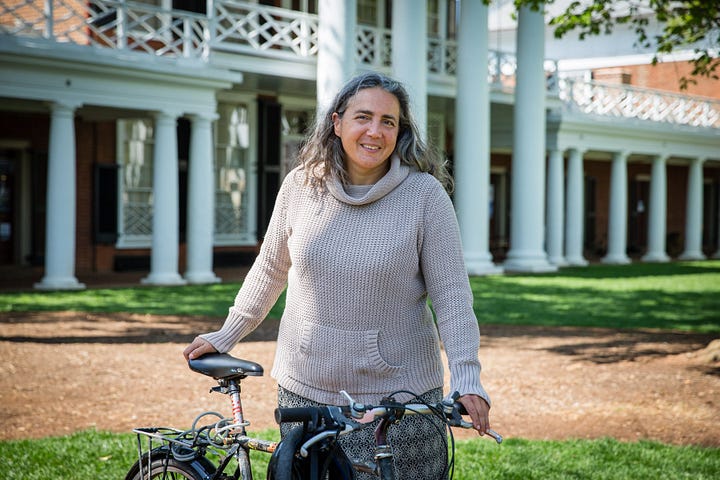
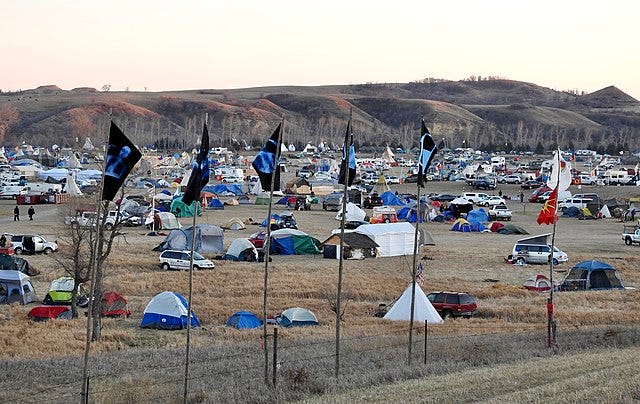
Meanwhile, another hiccup: Melissa might go to jail. She was an activist. Activists come in all personality types and political temperaments, the only common denominator being that they’re all, well, active. Melissa had a gentle, kind, and patient spirit. She lived in an intentional community, volunteered at an organization that promoted bicycle use, ran a story group for Big Blue Door, and supported many causes.
Part of her interest in the police stemmed from joining in the Dakota Access Pipeline protests in 2016. (These were protests organized by members of the Standing Rock Reservation against a shale oil pipeline that protestors felt endangered their drinking water.) The state sent police to clear the protestors. Melissa told me how at one point she was in a line of protestors facing a line of police across an open field. She saw this nice young officer over there not much older than her son and she couldn’t imagine that he—even if an order were given—would march across the field and act aggressively toward nice peaceful protestors like her. But it was and he did. Instead of coming away bitter, Melissa came away curious about how police felt about these sorts of situations.
Along with many protestors had been arrested. Usually, these sorts of charges would be dismissed but there was a lot of agitation against pipelines in the U.S. at the time, and activists feared the DAP protestors might be made an example of. Word came from North Dakota that she would have to go back for her hearing in person. It’s possible they would remand her right into custody with no bail. So she needed to get the interviews finished before she left.
Luckily, after several weeks the word somehow came down that Chief Thomas approved. He wouldn’t do an interview himself but officers were welcome to be interviewed if they wanted to be. About the same time former police chief Tim Longo came forward, encouraged by his neighbor who was one of our improvisers.* Soon other officers started coming in, person by person, very slow but steady, as word got out that it was an interesting and fun experience.
So Melissa was was on track.
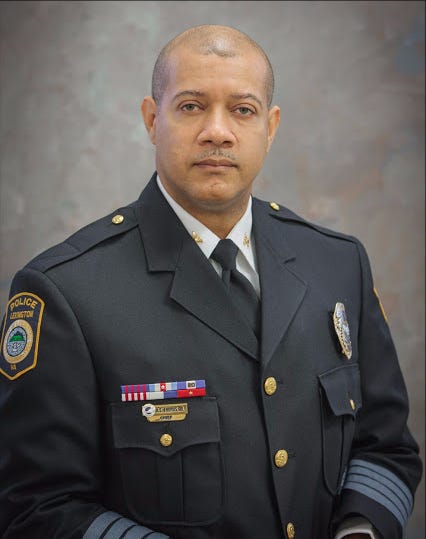
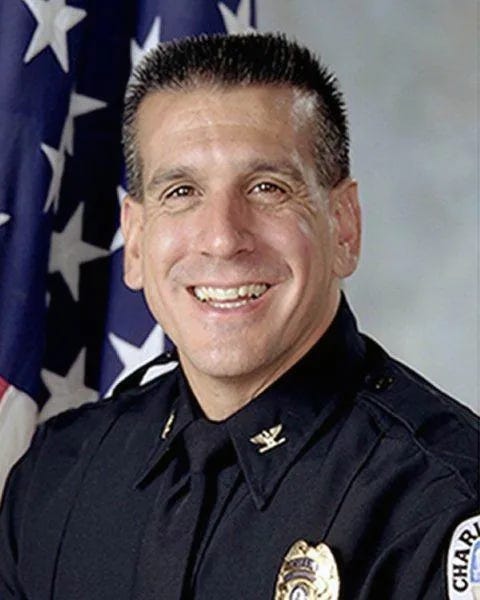
.
The Fundraising
While Melissa struggled at first but then things started to click, I hit the ground running but then things skidded to a halt. I raised a few hundred dollars right away from our regular Big Blue Door emails, posts, and my own contacts. I was nervous about the lack of interviews but once those started coming in, and the GoFundMe got going, it all looked good.
But then in early or mid-April (I can’t remember exactly) when I was about two thirds there, everything stopped. Completely. Just stopped. No gifts, no clicks, no nothing. And my second wave came to nothing: the local theater company would not touch it and some donors didn’t want their names mentioned. The donors weren’t exactly leaping at the chance to be associated with the police. The big grant-granting foundation couldn’t help me unless I was testing an academic theory or wanted to do ride-alongs (which would reinforce the work identity our model of interviews was designed to diminish). In the Cville-Bridge grant program where the general public got to vote on projects TrueVille got only three votes.
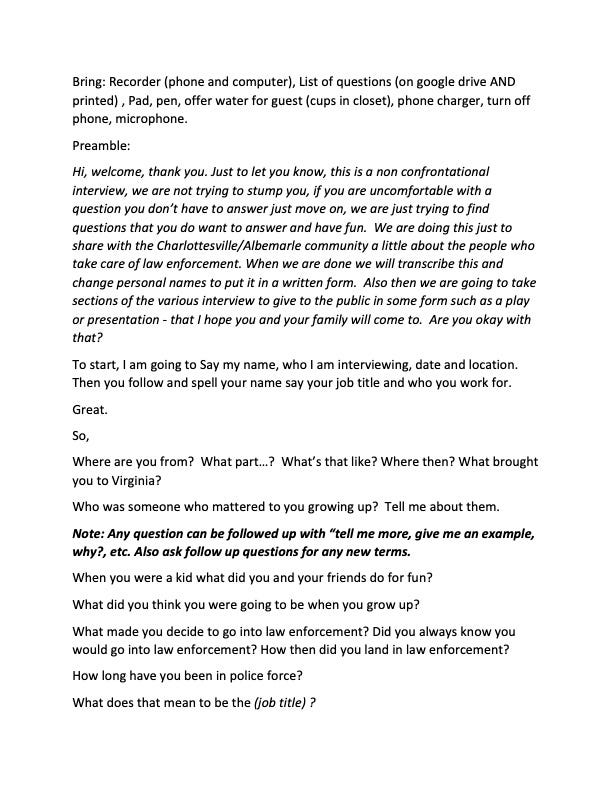
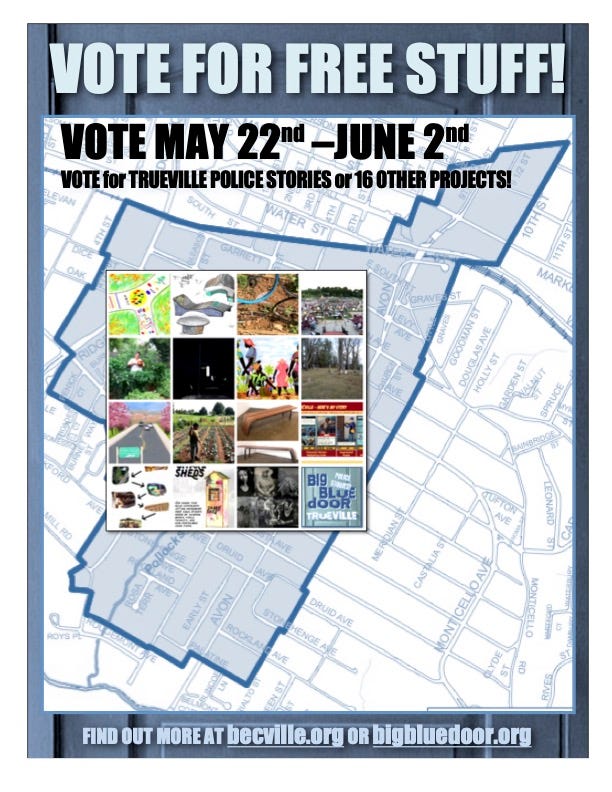
I tried serious approaches, silly approaches, sideways approaches, head-on approaches, but I just couldn’t seem to raise more money.
We had enough to cover the work we (Melissa, that is) had done already, but I had also promised a play? I need to say here I’m not an activist. I went to one homeless march in DC in the 80s because of a girl. It was a huge gathering and we marched until we arrived at a platform where there were speakers and celebrities. And I got this sinking feeling as I realized they didn’t have any actual plans. I felt ashamed. All these hard-working people had done all this work and I should be grateful, but all I could think was, Are we just here to commiserate with one another about injustice? Why would you bring us here before you had a plan?
So I wasn’t going to self-finance a play. Absolutely not.
May 13th - Day
By May 13th Melissa had returned from North Dakota with the charges dropped, completed all the interviews, and was finishing the transcripts. On my end two weeks had gone by without a single donation of any kind.
On walks with my daughter I tried to stay relaxed, just walk and think, and wait for something to come to me, when on that Saturday what came to me were three teenagers claiming they’d seen ‘Nazis’.
I’d worked at a school for kids with behavioral issues in the 80s and many of the teenage boys passed in and out of being punks, hardcores, straight edges, Neo-Nazi skinheads, anti-Neo-Nazi skinheads, and others–with different names, identities, politics, and music; I’d seen a KKK march in Asheville, NC in the 90s; I’d lived a year in Eastern Europe in the 00s where skinheads seemed everywhere. So I’d seen a lot of chaotic, tattooed, troubled young men squabbling and shouting.
I was actually a little irritated to be distracted from my brooding, but I magnanimously pushed my irritation aside, furrowed my brow to show what a caring person I was, and said something reassuring, vague, and mature about staying out of their way and it would all be fine.
They went there way and my daughter and I moseyed home where on Facebook I saw postings of recent videos from the incident.
What was then called Jackson Park is a miniature ‘City-Beautiful’ style grassy square next to the county courthouse (which confusingly is in the middle of the city) with some benches and bushes, and back then a statue of Stonewall Jackson.* In an open space just south of the statue a mob of a hundred or so in khakis, polo shirts, and high-and-tight haircuts, carrying Confederate flags, various fascist-style flags and symbols, and placards, as they chanted and shouted slogans like: Blood and soil. Hail Trump. Hail Victory. You Will Not Replace Us.
‘Blood and soil’ is the basic ur-fascist chant. Anyone saying it in public at the very least thinks Hitler was misunderstood. But the fascists I’d seen before couldn’t put together a Sunday potluck, while these guys were organized.
There were clips of the rally of the rally breaking up and the ralliers being followed as they dispersed, but it didn’t seem over really. And it wasn’t.
May 13th - Night
That night on Facebook and on news media which broadcast them around to world video clips appeared of the khaki-and-polo gang assembled after dark in nearby Lee Park in front of its namesake statue. This time they were holding lit Tiki torches to mimic old images of Klansmen.
It was a brilliant bit of propaganda, far beyond anything I’d seen far-right groups pull off in my lifetime. It looked intimidating, defiant, but with a kind of winking plausible deniability. Hey, we’re just having fun! Why is everyone else making a big deal about it?
1960s American Nazi Party marchers defied the public where they marched. That was their point. These Tiki torch guys were instead using the defiance of Charlottesville as a media story to reach the world. They were using Charlottesville for a recruiting photo op. Yes, the images would horrify most people, but horrifying most people would entice recruits among those who resent most people. Was it Mao Zedong who said something about the strategy to get the first 10 followers is different than the strategy to get the first 100, and that’s different than how you get the first 1000, and so on? These guys had used rallies to consolidate the 100 group, and now were using media to reach another 10,000.
May 14th
The next morning emails went out that there was to be a counter protest for Sunday night back in Lee Park. I heard it was put together by a local activist organization called Showing Up for Racial Justice but the literature says it was organized by a local Black Lives Matter chapter.*** It was to be a candlelight vigil. We were not supposed to post about this on social media because it might attract conflict. I wasn’t clear why we wouldn’t want conflict, but I wasn’t organizing it so it wasn’t my decision. My wife and I talked, and agreed that one of us should be present, so I walked over from Belmont.
There were lots of friends of mine there, including Melissa and her husband. People were handing out candles. There was a guy sort of lecturing. He was not talking about fascism or who the people had been who had protested. There was a banner hung on the Lee statue that read ‘Fuck White Supremacy.’ My heart sank. The f-bomb would mean the media wouldn’t show it on air for more than a few seconds if at all. Why couldn’t they write End White Supremacy or Stop White Supremacy? Why the profanity. I felt that shame. I should be grateful for all the work people put in to create this event and instead all I could think about was that this gathering would do nothing to counteract the propaganda success of the Tiki torchers.
As I was leaving I saw a lot of police near the perimeter of the park. I wondered if any of them had been interviewed by Melissa. It was hard to even think about something as trivial as raising money for a play.


Thanks for reading Blame Cannon! This has been Part 5 of Welcome to Charlottesville. Here are the sections in order: Part 1, Part 2, Part 3, Part 4. Here’s the explanation. New chapters come out every Tuesday. By Friday or this weekend I hope to have a bonus post. Please subscribe and share.
*Tim Longo was appointed Police Chief of UVA in 2019. In that job he was criticized recently for his handling of Pro-Palestine protests on UVA campus. Most of his critics seem to consider him a well-intentioned person who screwed up, not an authoritarian or hothead.
**The Jackson statue was sculpted by Charles Keck and presented to the city in 1921 as a gift from Paul Goodloe McIntire. McIntire also donated the statue of Robert E Lee mentioned here by Henry Shrady and finished after Shrady’s death by Leo Lentelli. We’ll come back to the statues and the controversy surrounding them. Believe that.
***The best book about these events is Summer of Hate by Hawes Spencer © 2018 University of Virginia Press. Available at your favorite local book seller. Hawes has been part of downtown forever and knows the people well. Unforunately, it doesn’t have an index.

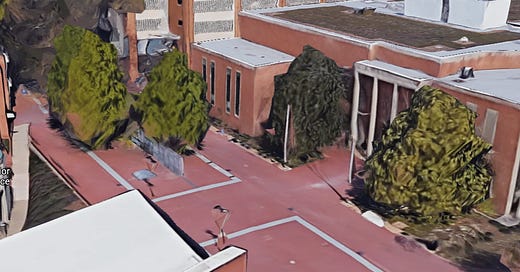



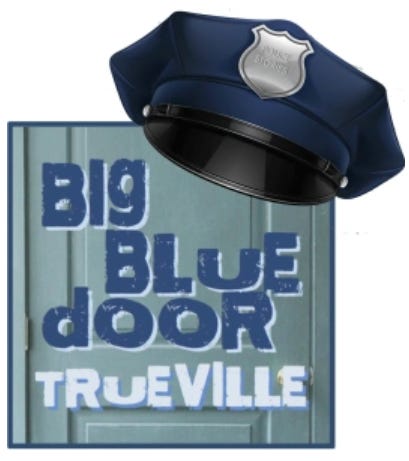
You have the same sorts of responses to these things that I would have, e.g., the profanity. I remember when I first spoke up on social media (which I used then more politically) to say that "Defund the Police" was a losing slogan, or even concept, from any angle. I was excoriated from many people who said who the heck was I to know what was best? Well, it has not been a pleasant feeling to be proven right.